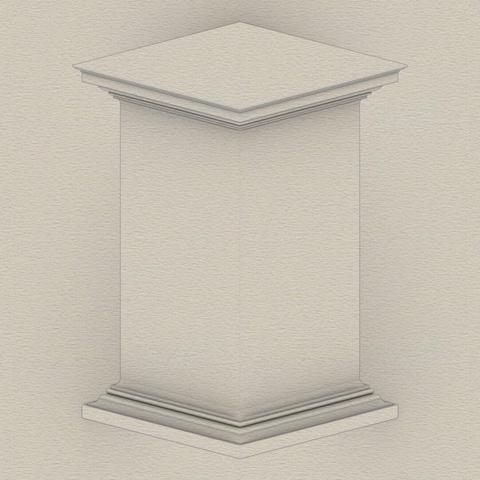#lonic
#Vignola divided µ into 12 parts for the #Tuscan and #Doric orders, and into 18 parts for the #lonic, #Corinthian and #Composite orders. To make it easier to move between the orders, it is helpful to choose a value for µ that is a multiple of both 12 and 18. We could start with module µ = 36, which is the least common multiple of 12 and 18.
However, in classical design, it's a lot easier if minor grid lines are multiples of 8 (as in music 'octaves' and poetry 'octets'). So, I use a grid with minor grid marks at 8 and major grid marks at 32, which leads us to choose µ = 144 as that is the least common multiple of 12, 18, 8, and 32.
This value of µ = 144 is still abstract because we haven't chosen a physical unit like mm or inch, but it does not matter at this point. Once the model is constructed with the chosen value of µ, it can be scaled up or down in software to get the desired column width or order height in physical units.
The total height of columns for the same µ are in the ratio 7:8:9:10 for the #Tuscan, #Doric, #Ionic, and #Corinthian, with #Composite the same as Corinthian. When µ = 144, the diameter is 288. So the height of the Ionic column is 288*9 = 2592 units.
The #pedestal, #column, and #entablature are always in 4:12:3 ratio across all orders. So the height of the Ionic pedestal is 864 and height of the entablature is 648, and the total height of the order is 4104 units.
Remember that in the Ionic order, µ is divided into 18 "parts". So each part is 144/18 = 8 units. With this we can convert between µ and parts in either direction.
Total order height of 4104 units is then 4104/8 = 513 parts. If you are trained in computer science, you will grow despondent that it is 513, not 512. Let go, and everything will be all right.
The pedestal is the easiest component, and we start with that.
⬆️ #CAD #3DModeling
>> #Vignola divided the #module 'µ' into 12 parts for the #Tuscan and #Doric orders, and into 18 parts for the #lonic, #Corinthian and #Composite orders.
Even though actual module value will depend on the size of the physical object, it is advantageous to start with a value that is a multiple of both 12 and 18 in the CAD model and let software scale everything later as necessary.
You could start with module µ = 36, which is the least common multiple of 12 and 18.
⬆️ #CAD #3DModeling
>> #Vitruvius called the diameter a "module" — an abstract unit of measure independent of physical units.
#Vignola divided the #module into 12 parts for the #Tuscan and #Doric orders, and into 18 parts for the #lonic, #Corinthian and #Composite orders.
The module value will depend on the size of the physical object (column width or height) you want to realize from the CAD model, whether it for large buildings or small 3D-printed artifacts.
https://babel.hathitrust.org/cgi/pt?id=mdp.39015031201190&view=1up&seq=18
